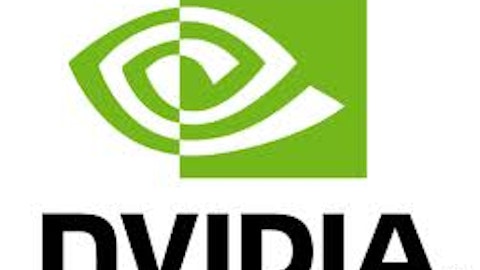It hasn’t been an easy period for NVIDIA Corporation (NASDAQ:NVDA) in the last few years, as weakness in PC sales hurt the chipmaker’s revenue. However, lately things seem to be looking up for the company. In the latest earnings report released last week, the company delivered earnings that came in ahead of the consensus. Additionally, the firm announced its plans to return more cash to shareholders. It looks like NVIDIA Corporation (NASDAQ:NVDA) might enjoy a pretty good year.
Strong First Quarter
The company announced first-quarter EPS of $0.13, beating the consensus by over 30%. This was up from $0.10 in the same period a year ago, though nowhere near the $0.22 the company reported for Q1 2012. While earnings have been rising over the last few years, the company has not managed to return to its pre-crisis earnings level.

There were several impressive points in the Q1 2014 report. First of all, the company’s gross margin improved 1.4% sequentially to a record 54.3%, reflecting a higher margin product mix and the company’s focus on cutting costs. Secondly, while the company released the Geforce GTX Titan three months ago, a high end PC graphics card which has so far been very well received, the company is increasingly looking toward its Tegra line of mobile chips to sustain growth as PC sales dwindle. The Tegra 4 is now seeing incorporation in various mobile devices.
Revenue was less positive, down 13.7% from Q4 2013, but up compared to the same period a year ago. Much of this was due to manufacturers replacing the Tegra 3 with the Tegra 4 line, and management expects higher revenue in Q2 with the same gross margin. Finally, the company announced plans to return more cash to shareholders in the form of stock buybacks, totaling over $1 billion for the fiscal year.
Stiff Competition
NVIDIA Corporation (NASDAQ:NVDA) has a strong position in the PC GPU market, but the firm has a lot of competition in the mobile chip space. QUALCOMM, Inc. (NASDAQ:QCOM) is probably the most dominant player here, and has been doing an impressive job of growing the top and bottom line. For the latest report, the company’s revenue was up 24% year-over-year, and operating income also rose 24%. The company’s immensely popular Snapdragon processor has cornered much of the market, and the company is expected to keep up its strong performance.
In the PC GPU space NVIDIA Corporation (NASDAQ:NVDA) has only one real competitor, Advanced Micro Devices, Inc. (NYSE:AMD), and this company hasn’t been faring too well. The firm has posted losses for the last three quarters, although two of those reports came in ahead of the consensus. Advanced Micro Devices, Inc. (NYSE:AMD) now has around 36.3% of the GPU market, a number which is decreasing. On the other hand, the company has recently entered the console graphics market, which may provide some growth opportunities for the struggling chipmaker.
Valuations and Metrics
NVIDIA Corporation (NASDAQ:NVDA) currently looks more or less fairly valued, with the stock trading at 15.3 times trailing earnings. QUALCOMM, Inc. (NASDAQ:QCOM) is a bit more expensive at 18.2 times trailing earnings, but also has considerably higher growth. While NVIDIA has been improving its gross margin, it’s still not up to Qualcomm’s level, the company achieving around 62%. NVIDIA’s price-to-sales of 2.04 is quite reasonable, as is the price-to-book at 1.82. NVIDA’s return on equity of 12.73% is decent, and they furthermore have a great balance sheet with nearly no debt and some $3.71 billion in cash.
The Bottom Line
After several tough years due to the steep decline in PC sales, things seem to be improving for NVIDIA. The company is doing a fairly good job of keeping up with the mobile chip market, and still has a strong position in the PC GPU market. The company’s prospects for the rest of the year look encouraging, and with quite a fair valuation, the stock could see more upside through the year.
The article This Chipmaker Is Shaping Up for a Good Year originally appeared on Fool.com and is written by Daniel James.
Copyright © 1995 – 2013 The Motley Fool, LLC. All rights reserved. The Motley Fool has a disclosure policy.
